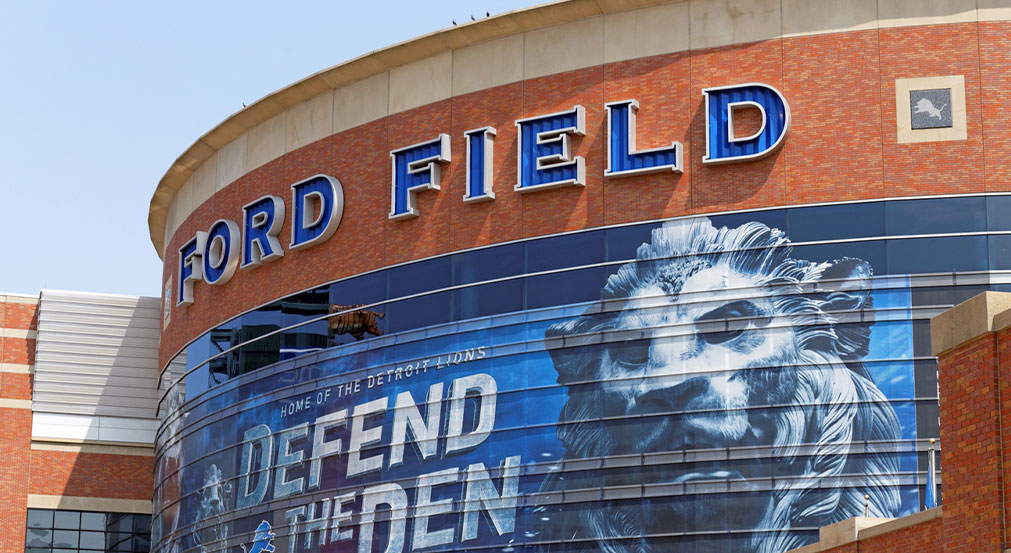CoStar News | November 26, 2022 | 8:03am
The eight U.S. cities chosen to host Final Four games of college basketball’s men’s and women’s championship tournaments starting in 2027 will be looking to turn March Madness into big spending by visitors at local bars and restaurants, stores, hotels and other venues.
Division I committees for the National Collegiate Athletic Association this week announced that games featuring the men’s Final Four teams will take place in 2027 at Ford Field in Detroit, in 2028 at Allegiant Stadium in Las Vegas, in 2029 at Lucas Oil Stadium in Indianapolis and in 2030 at AT&T Stadium in Arlington, Texas.
The women’s Final Four will compete in 2027 at Nationwide Arena in Columbus, Ohio; in 2028 at Gainbridge Fieldhouse in Indianapolis; in 2029 at Alamodome in San Antonio, Texas; in 2030 at Moda Center in Portland, Oregon; and in 2031 at American Airlines Center in Dallas.
Many cities see the nationally televised basketball events as a tourism showcase as well as a source of regional pride that could also encourage future business development. When Dallas hosted the NCAA women’s Final Four in 2017, that city’s Sports Commission estimated the regional economic impact at $30 million, including money spent at hotels, restaurants and entertainment venues.
Similar agencies in other cities estimated that this year’s NCAA tournament hosting stints, including those that took place in stages prior to the Final Four games, generated around $10 million in San Diego, $10.5 million in Pittsburgh and $6.5 million in Milwaukee. The latest hosting gigs are further payoff for cities including Las Vegas and Dallas, which have seen significant development of new sports facilities in the past decade that have attracted a series of high-profile events.
“Our region and its commitment to invest in the future gives us incredible assets to provide great experiences and create a lasting impact with the Final Four,” Dallas Cowboys owner Jerry Jones said in a Nov. 22 statement from AT&T Stadium, developed by Jones at a reported cost of $1.3 billion.
Jobless Claims Edge Higher
Initial claims for unemployment insurance rose 17,000 from the prior week to 240,000 for the week ended Nov. 19, the Labor Department reported Wednesday. The four-week moving average was 226,750, marking an increase of 5,500 from the prior week in a climate where claims remain low by historical standards, with the unemployment rate at 3.7% as of October.
Continued claims in all unemployment programs, tracked on a more delayed basis, totaled approximately 1.3 million of the week ended Nov. 5, down 35,091 from the previous week and staying well below the approximately 2.3 million claims for the comparable week of 2021.
Cumulative data shows initial claims have been edging up since hitting a low of 166,000 in March but remain close to weekly averages seen before the pandemic in 2019. Analysts have noted that while claims have been rising, they have not yet jumped considerably as a result of a series of recent high-profile layoffs at large companies, especially big technology firms.
Mortgage Applications Rise Again
The volume of U.S. mortgage applications rose for a second straight week for the period ended Nov. 18, aided by a tick-down in lending rates that remain considerably higher than a year ago, the Mortgage Bankers Association reported Wednesday.
Applications overall rose 2.2% from the prior week. Purchase applications increased 3% from the previous week but were down 41% from a year earlier, while refinance applications were up 2% for the week but declined 86% for the year, the trade group reported.
“The 30-year, fixed-rate mortgage fell for the second week in a row to 6.67% and is now down almost 50 basis points from the recent peak of 7.16% one month ago,” Joel Kan, the trade group’s deputy chief economist, said in a statement. “The decrease in mortgage rates should improve the purchasing power of prospective homebuyers, who have been largely sidelined as mortgage rates have more than doubled in the past year.”
Other analysts note those prospective buyers include renters who have remained in the apartment pool while waiting for prices and interest rates to come down, keeping demand for multifamily properties high in many regions.





